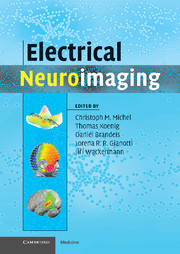Book contents
- Frontmatter
- Contents
- List of contributors
- Preface
- 1 From neuronal activity to scalp potential fields
- 2 Scalp field maps and their characterization
- 3 Imaging the electric neuronal generators of EEG/MEG
- 4 Data acquisition and pre-processing standards for electrical neuroimaging
- 5 Overview of analytical approaches
- 6 Electrical neuroimaging in the time domain
- 7 Multichannel frequency and time-frequency analysis
- 8 Statistical analysis of multichannel scalp field data
- 9 State space representation and global descriptors of brain electrical activity
- 10 Integration of electrical neuroimaging with other functional imaging methods
- Index
- References
8 - Statistical analysis of multichannel scalp field data
Published online by Cambridge University Press: 15 December 2009
- Frontmatter
- Contents
- List of contributors
- Preface
- 1 From neuronal activity to scalp potential fields
- 2 Scalp field maps and their characterization
- 3 Imaging the electric neuronal generators of EEG/MEG
- 4 Data acquisition and pre-processing standards for electrical neuroimaging
- 5 Overview of analytical approaches
- 6 Electrical neuroimaging in the time domain
- 7 Multichannel frequency and time-frequency analysis
- 8 Statistical analysis of multichannel scalp field data
- 9 State space representation and global descriptors of brain electrical activity
- 10 Integration of electrical neuroimaging with other functional imaging methods
- Index
- References
Summary
Introduction
High density spatial and temporal sampling of EEG data enhances the quality of results of electrophysiological experiments. Because EEG sources typically produce widespread electric fields (see Chapter 3) and operate at frequencies well below the sampling rate, increasing the number of electrodes and time samples will not necessarily increase the number of observed processes, but mainly increase the accuracy of the representation of these processes. This is namely the case when inverse solutions are computed.
As a consequence, increasing the sampling in space and time increases the redundancy of the data (in space, because electrodes are correlated due to volume conduction, and time, because neighboring time points are correlated), while the degrees of freedom of the data change only little. This has to be taken into account when statistical inferences are to be made from the data. However, in many ERP studies, the intrinsic correlation structure of the data has been disregarded. Often, some electrodes or groups of electrodes are a priori selected as the analysis entity and considered as repeated (within subject) measures that are analyzed using standard univariate statistics. The increased spatial resolution obtained with more electrodes is thus poorly represented by the resulting statistics. In addition, the assumptions made (e.g. in terms of what constitutes a repeated measure) are not supported by what we know about the properties of EEG data.
From the point of view of physics (see Chapter 3), the natural “atomic” analysis entity of EEG and ERP data is the scalp electric field.
- Type
- Chapter
- Information
- Electrical Neuroimaging , pp. 169 - 190Publisher: Cambridge University PressPrint publication year: 2009
References
- 25
- Cited by



